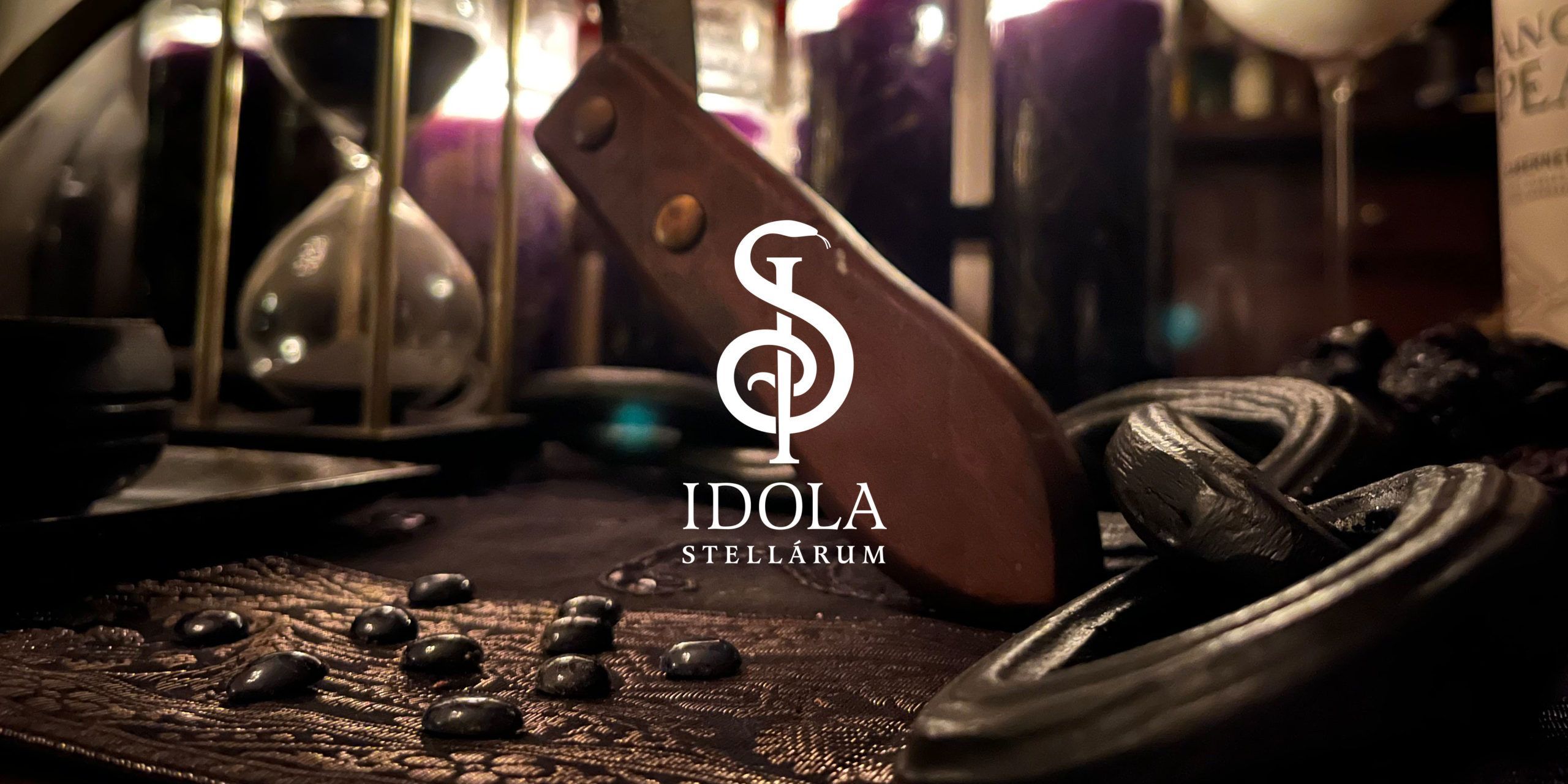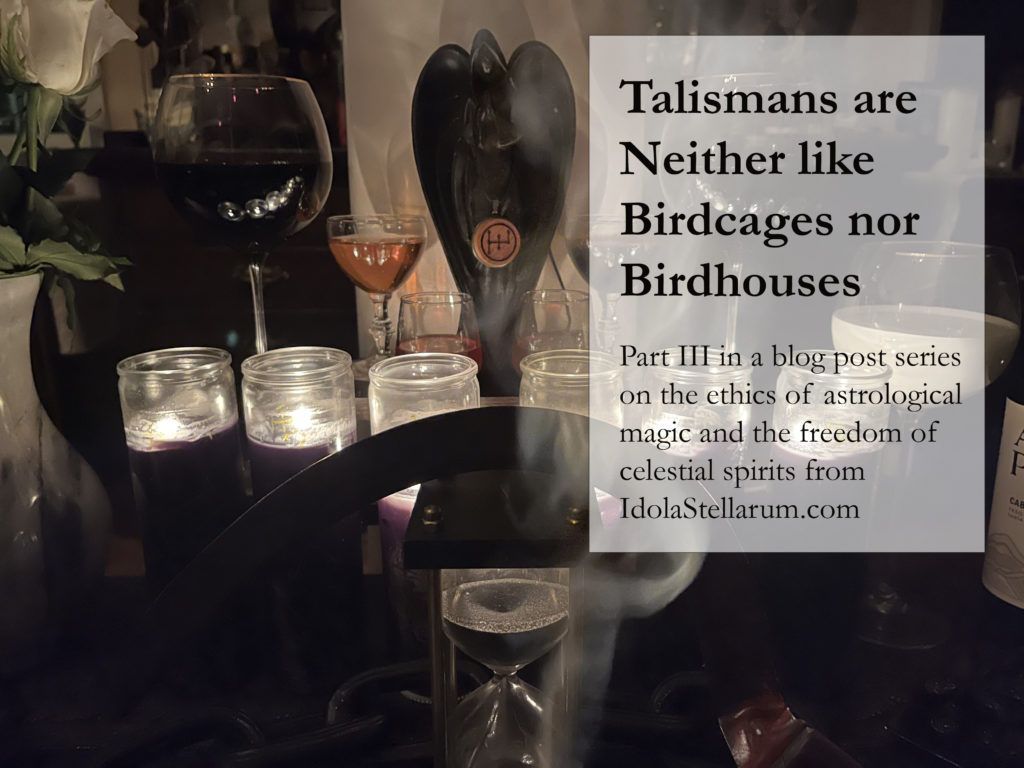Your cart is currently empty!

Talismanic Gemstones are Neither like Birdhouses nor Birdcages: An Ecological Spirit Model Perspective On the Essential Freedom of Celestial Spirits (Part III)
In Part I of this post series on the freedom of celestial spirits, we used traditional sources to reject the idea that talismans are like birdcages that trap spirits inside them.
In Part II of this post series, we deepened this idea by proposing another metaphor: that a talisman could be thought of as more like a birdhouse than a birdcage, and that astrological mages can act respectfully by using quality materials to build the best birdhouses possible.
In this third part of this post series, we consider a more integrated and ecological perspective that moves away from potential implicit materialistic assumptions about talismans and the materials out of which we make talismans. When we get down to the heart of things, we realize that talismans are neither like birdcages nor like birdhouses, but some secret third thing.
Zooming Out from Our Assumptions About Spirits
In Part I, we introduced two perspectives within the astrological magic tradition: the natural magic model, which holds that astrological magic simply magnifies natural powers already present, and the spirit model, which holds that astrological magic invites a spirit of the celestial hierarchy to reside within a piece of talismanic jewelry. Our own perspective harmoniously blends these two models by taking a wider view of spirits and nature.
Natural magicians were careful not to draw negative attention from the church. Marsilio Ficino in particular was at pains not to endorse a spirit model, lest he be accused of violating Christian orthodoxy. He ended his Three Books on Life with a dig at “how impure was the superstition of the heathen” and emphasizing “how pure was the piety of the [Christian] Gospel,” after all!
For reasons having to do with skirting charges of heresy and also integrating magical practices with the emerging scientific perspective, in the natural magic framework there was no room for acknowledging or working with spirits of any kind other than perhaps the angels of heaven. Contemporary perspectives that rely on some understanding of celestial rays make the same presupposition: we can ignore the world of individual spirits and just think about “nature,” even if we do understand nature in a somewhat wider sense than the perspective of atheistic materialism.
Even within the spirit model, however, there can be an unconscious pull to ignore spirits outside of the celestial hierarchy. The worry that an astrological talisman is like a birdcage, or the view that a talisman is like a birdhouse, might fall prey to this kind of unconscious assumption: that the gemstone or metal of a talisman is simply an empty vessel that we could somehow keep a spirit inside. But if that were true, why stop at putting a celestial spirit in a gemstone? Why not move a fox’s spirit into a stone, a honeybee’s spirit into a dried flower, or a bird’s spirit into a fallen tree branch? Hopefully it’s clear that on some level this idea is not entirely coherent.
From a more deeply integrated and ecological perspective on spirit, it is not as if a jewel or a stone is not already inspirited. As the Picatrix states, “there are connections and continuities between matter and the World Soul, which flow daily over natural things” (Book I, Ch. 36). Just as the celestial hierarchies have their intelligence and each person has their own personality and soul, each stone already has its own share of spirit. The streams and rivers, the flowers and trees, the stones and shells are all always already full of spirits.
Rethinking “Occult Virtues” within an Ecological Spirit Model
Thinking within a worldview in which “all things are full of gods,” as the pre-Socratic philosopher Thales put it, we need to revisit the idea of a talisman as a birdhouse that we introduced in Part II of this post series. If every gemstone already has its own spirit, we are obliged to admit that in some sense there could be no such thing as a ‘cage’ or even a ‘house’ that could be serve as an empty vessel for a celestial spirit to enter.
The Anima Mundi, the World Soul, subtends and suffuses all of reality and each thing, down to the least sparrow and speck of sand, shares in the animated, ensouled nature of the cosmos. There is no emptiness of spirit: there is simply matter manifest as the action of spirit always already present. This merits a deeper reconsideration of what it means to use better “quality” materials for talismans.
Within the Renaissance magical worldview, each type of thing possesses certain occult virtues that align it with some celestial powers and not others. To use an analogy, while almost anything will burn if the flame gets hot enough, some things like dry tinder or the head of a match will more readily catch a spark. Agrippa relies on a similar metaphor to explain why certain materials and not others are more effectively used for particular workings:
“Now if you wish to accept a virtue from any part of the world or star, use that which the star holds under its particular influence, just as wood prepared with sulfur, pitch, and oil accepts flame. Nevertheless, when certain species or individual things (many of which are scattered) that conform to the same Idea and star are used correctly, suddenly through this appropriately prepared matter a singular gift is infused by reason of the World Soul.”
Agrippa, Three Books of Occult Philosophy, Book I, Ch. 34
This way of looking at things corresponds to a kind of Neoplatonic view of the world in which things inherit their qualities (“virtues”) from the Ideas higher up the chain of being, and ultimately from the World Soul. This view is easily assimilated to a kind of natural magic perspective, which can become quasi-mechanistic. The Agrippa quotation above continues: “Now, when I say, ‘appropriately prepared,’ [I mean] under a harmony similar to the harmony of the former virtue that was infused into the matter.” The fitness of a given stone or metal for a given talisman, then, gets attributed to a higher organization or harmony, rather than to the spirits themselves.
Let’s think about this from within an ecological spirit model. We have established a view in which making an astrological talisman does not put a spirit into an empty stone, but rather joins or unites (“coadunates”) a celestial spirit with a sublunary spirit. Instead of talking about the harmony of specific occult “virtues” that could be ascribed either to inanimate matter or to a higher order of Ideas, we might instead think about relational terms like friendship, alliance, or (more personal) affinity.
Thinking with these ideas offers a new perspective on why gemstones in general (and specific types of gemstones for specific entities in the celestial hierarchy) work more effectively for astrological magic than any random pebble you might find on the road. The spirit already residing in a piece of pyrite, say, has more capacity and affinity for cooperating with a spirit of Saturn or Sol than any old shard of sediment you might pick up on the streambank.
Likewise, perhaps an emerald serves as an excellent vessel for spirits of Jupiter, Venus, or Spica because emeralds like, appreciate, or show deference to spirits of Jupiter, Venus, or Spica—and/or vice versa. Inviting a spirit of the fixed star Spica into an emerald “works” better than inviting it into a garnet or a pebble because the spirit of Spica gets along better with the spirits of emeralds.
Just as you might prefer to socialize with one person and not another, and you might more effectively collaborate with certain people and not others, so too it is straightforward to imagine that spirits have their own personalities that lend to a complex range of affinities, alliances, enmities, and even perhaps indifferences. This view would invite us not to memorize lists of correspondences, but to get to know our materials and introduce ourselves to them to better understand their personalities, as it were.
This ecological spirit model framework obviously has fidelity to the essence of the spirit model, but also captures a key intuition of the natural magic model. Astrological magic really does augment natural powers already present in the stone: those powers just have to do with the spirit of the stone, rather than qualities of inanimate matter, or matter that simply inherits its indistinct share of spirit from the Ideas or from the World Soul.
In this model, the mage does not trap a spirit in a stone, or even move a spirit from one level of reality into another. These ideas of inside/outside, or material/spiritual, rely on dualisms that do not capture the relationality of the world and of spirits. The act of celestial ritual does not create a new object, but potentiates, enhances, or deepens an already existing relationship between the heavenly and the material—for the material already participates in the divine.
At Idola Stellarum, we are committed to thinking and working with ideas that show the greatest amount of respect and fidelity to the spirits that we work with—of course including those of the celestial hierarchy, but also down to our stones, our tools, and the very land we work upon. You can read more about our philosophy and approach on our About page.
As stewards of the tradition of astrological magic, it is our privilege to bring the wonder of astrological talismans to others. Sign up to our mailing list for word of our upcoming talismanic collections and workings:
By clicking ‘subscribe’, I consent to Idola Stellarum storing my email and information solely for the purpose of communicating upcoming offerings and content, and I am able to unsubscribe at anytime.

